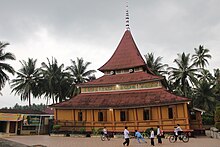|
Architecture of Sumatra The Indonesian island of Sumatra is the sixth largest island in the world. The rich ethnic diversity and historical heritage in Sumatra is reflected in the range of architectural styles in the island. The vernacular style is the native Sumatran ethnic groups architecture of dwellings, while the Hindu-Buddhist architecture reflected through the cultural historical heritage of candis built in Sumatra. The third wave is Islamic architecture adopted in mosques and palace in Sumatra, especially in Aceh, North Sumatra, and Malay cultural sphere in the island. Vernacular architecture The traditional vernacular architecture including:
Hindu-Buddhist architecture Several Hindu-Buddhist architecture in the form of candis (temples) dated from 7th to 13th century are found scaterred in Sumatra. These temples are mostly linked to Buddhist maritime empire of Srivijaya. Although not as grand and elaborately designed as Hindu-Buddhist temples of Java, the temples of Sumatra mostly built from red brick material have their own style, these temples among other:
Islamic architecture Islam reached northern Sumatra first before any other part of the archipelago. The Islamic architecture adopted in Sumatran Sultanates mosques and istanas (palaces). The most notable architecture influences are Persian and Indian Mughal architecture. Examples of Islamic architecture in Sumatra are:
See also |